WesMex 2017 - Kids Racing For Gold & Learning About Life

Racing sailboats is a fantastic way for young kids to gain valuable life skills. As a boy growing up on Long Island Sound, I learned to sail and developed competitive skills racing “Bluejays” and “Lightnings” at the Noroton Yacht Club in Connecticut.
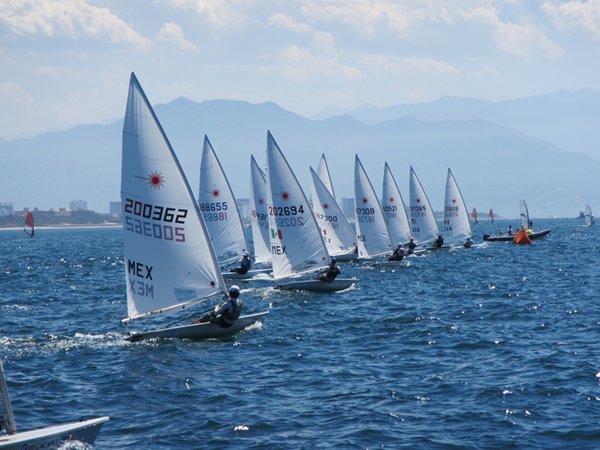
Recently, Margie and I volunteered Peregrina as a committee boat in the 2017 WesMex Junior Sailing Regatta in Banderas Bay, Mexico. The event was organized by the Puerto Vallarta Yacht Club. This is the 12th year the club has hosted the race which is a World Championship qualifier for select international events.
Over 240 boats participated in the regatta in five types of one-design sailboats:
- Optimists - Lasers - Windsurfers
- C420 - Hobies
The wonderful thing about racing one-design sailboats is that each boat is manufactured with identical specifications and the only real variable is the condition of the sails and the talent of the skipper. One- design racing is intense and competitive. There are wild and crazy starts and, often, very, very close finishes!
During the event, I met some fantastic Mexican kids and their supportive families. I was really impressed by the participants and began to think about some of the benefits of racing sailboats for young people. Below, I list some of the benefits and why I think sailboat racing is a good way for kids to learn these skills.
PREPARATION
Getting ready to race requires lots of preparation. Every morning, the kids would be working on their boats; cleaning, checking the knots, adjusting tension, repairing damage.
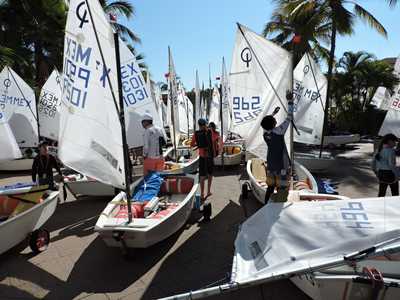

The older kids did most of this work themselves but, with the younger kids, the parents and coaches hovered around like alien spaceships providing advice, direction and last minute instruction. In some cases, Mom was there putting on sun cream - seemingly to this young man’s chagrin!

Kids also learn the importance of safety. This young girl is putting some extra air in the flotation bladders which keep her boat from sinking in the event she capsizes.
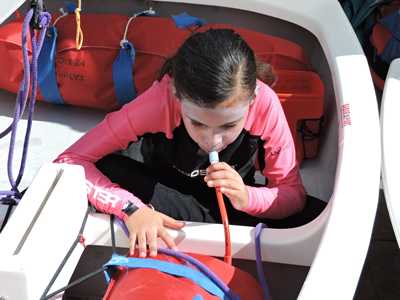
Every sailor knows that one broken rope, one slipped knot or one loose fitting can mean the end to the race. If your boat breaks down, it’s simple…you lose.
SOCIAL SKILLS
The kids in the WesMex regatta came from all over Mexico. It was wonderful to see kids introducing themselves and making new friends. In a three day regatta, there is no time to be a wallflower.
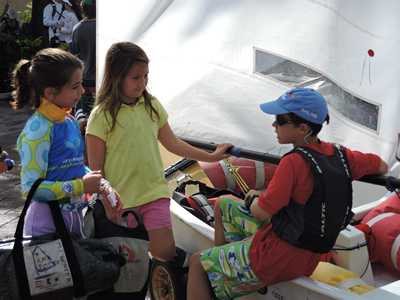
Even in the midst of serious racing, the kids had a sense of fun!
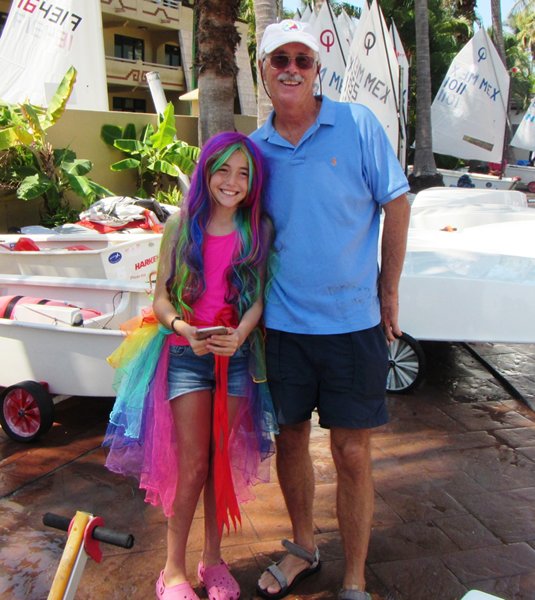
RULES & STRATEGY
To be a successful racer, the kids need a thorough knowledge of the rules as outlined in the Racing Rules book. This book contains hundreds of rules governing all aspects of racing. It is the same rules book used in the America’s Cup! No matter your age, you have to know the rules to have a chance of scoring well.
Once you know the rules, you can use them to formulate a strategy. Strategy is probably the most important aspect of winning races. The reason is that sailing fast is just not enough. Besides your ability to make the boat go fast, your progress is affected by changes in wind direction, wind speed, current direction, current speed, tides, wave direction, wave height, wave frequency and, of course, where your competition is sailing.
Kids have to take all these items into consideration, formulate a strategy and then constantly modify their tactics as all the variables change. This is serious brain-matter stuff!
PRACTICE, PRACTICE, PRACTICE
One of the principle ways to improve your race results is “time on the water.” Most kids belong to racing clubs where coaches get them out on the water every week in all sorts of conditions. They practice drills over and over. Generally, competitors even come out before a big race to practice. Here is a team doing downwind heeling drills.
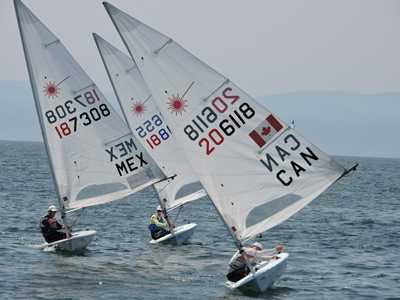
But, back to the race…On board Peregrina, which was the Start Boat for Lasers and Windsurfers, we had two Professional Race Officials, Bernice and Bernardo. They each traveled over 12 hours to get to Puerto Vallarta for the race.

In addition to the Race Officials, there are judges on the water in small motorboats who issue penalties for breaking the Racing Rules instructions. What’s more, competitors can protest each other and, following the race, a formal protest hearing will be held where the kids have to try to win their protest citing specific rules from the Racing Rules book. Both kids will present their case, cite the applicable Racing Rules, get questioned by the protest judges and then a ruling will be rendered. No parents are allowed!
STARTS
One of the most challenging parts of the race is the Start. Timing is everything. Racers must quickly evaluate a number of conditions affecting their position vis à vis the starting line and implement a series of tactical moves to place themselves in front of the fleet. Usually, a start consists of a five minute warning and a countdown. The time is communicated to the kids via flags and horns. Here is Margie raising the four minute flag.
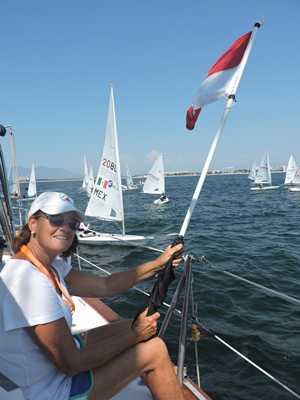
Shortly before the start all the boats line up. The kids have to be watching out not to “foul” another boat, not to cross the line too early, to show restraint when needed and to anticipate how long it will take to arrive moving fast when the staring horn sounds. There is a lot of stress on the starting line and the kids must learn to manage it. Below, you see how close the Laser Class lines up at the start of their race.
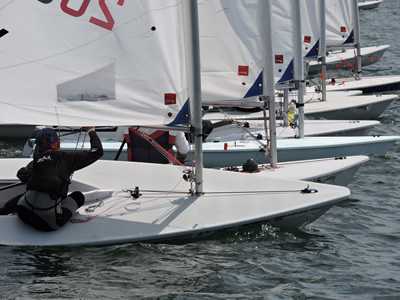
The Windsurfer “Techno” Class approaches the start beneath the majestic mountains surrounding Banderas Bay.

The members of the “Elite” Class of windsurfers were, truly, awesome athletes attaining speeds over 30 miles per hour. This young man represented Mexico in the Windsurfer World Championships in Miami last January. (FYI – the world record for windsurfing is 55 mph!)

ENDURANCE
We tried to get in three races every day whenever possible. Thus, the kids were in the boats 5-6 hours a day and WOW did they get tired! Below is a young competitor who finished getting his boat up into the parking lot after the racing and fell asleep on the stern.

WINNING & LOSING
The hard part of sailing is learning how to win and, much more frequently, learning how to lose. Usually, there are only trophies for 1st, 2nd and 3rd place in each class so the vast majority of the kids go home with only the knowledge that they did better or worse than hoped for. After one race, the boy below just sat on his boat for about 15 minutes staring straight ahead. A tough lesson, “yes”, but important nevertheless.

For the winners, there were smiles and cheers all around!
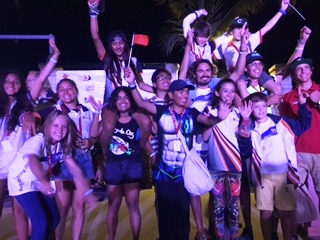
And for a select few, the race took on gargantuan proportions. At the end of the awards ceremony, the International Race Committee delegate came up to the stage and, one-by- one, called the names of five boys and girls who had qualified to participate in the 2017 Optimist World Championships in Thailand! Everyone went wild as these kids, so thrilled they could barely contain themselves, came on stage. What an awesome future is in store for these incredible young sailors! What a fabulous experience for two old salts like ourselves to be a part of it all!
And so, another chapter in our sailing adventure comes to an end. We’re looking forward to what come next…
Safe seas and following winds with love from Margie and Peter
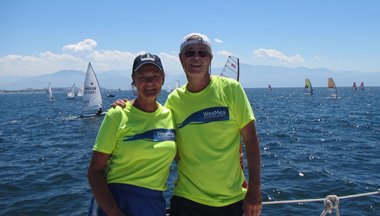
[Dear Readers. We love to hear from you, so please do write but send us a NEW email. If you hit “reply” all the pictures will come back. We have limited bandwidth. Thanks so much!]
--
--